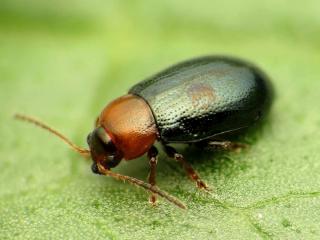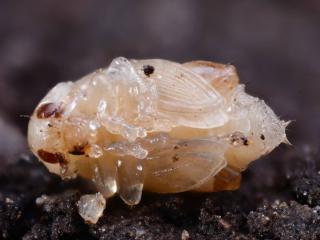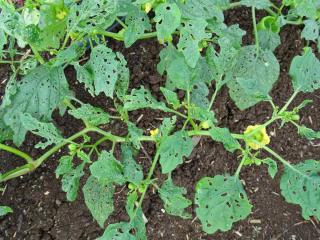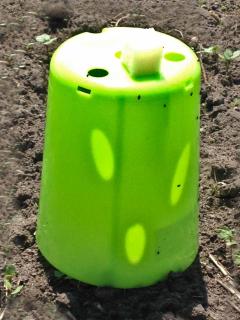

This little jumping flea beetle is especially fond of vegetable garden foliage, which it cheerfully perforates! Discover how to recognize flea beetles and which natural treatments to use to eliminate them.
 Flea beetles measure between 1/16 inch and 3/16 inch (2mm and 5mm) long. They have a black color back with metallic blue reflections and the rest of the body is brown. Some species like Phyllotreta nemorum have a yellow stripe on their back.
Flea beetles measure between 1/16 inch and 3/16 inch (2mm and 5mm) long. They have a black color back with metallic blue reflections and the rest of the body is brown. Some species like Phyllotreta nemorum have a yellow stripe on their back.
They are all equipped with two long antennas, and two hard, shiny wings. Rear legs are very developed, they allow them to jump high and have earned them the nickname of “earth fleas”. The larvae are nestled underground, it is the adult insects that we observe on the leaves. When they are disturbed, they drop to the ground.
There are several species of flea beetles: cruciferous flea beetle, corn flea beetle, potato flea beetle, grapevine flea beetle…
 After a winter spent underground, or hidden under a pile of leaves, flea beetles come out of their hibernation in May. Depending on the species, they begin to nibble the leaves of their favorite plants. A female lays eggs at the base of seedlings to provide food for its offspring. This laying takes place in spring but females also lay before winter, underground.
After a winter spent underground, or hidden under a pile of leaves, flea beetles come out of their hibernation in May. Depending on the species, they begin to nibble the leaves of their favorite plants. A female lays eggs at the base of seedlings to provide food for its offspring. This laying takes place in spring but females also lay before winter, underground.
Larvae then feast on roots of young plantlets. They also penetrate inside plants and burrow galleries inside. Any larvae that hatched in fall, might even spend the winter inside the plant and come out in spring to pupate underground.
A single female flea beetle can lay up to 1000 eggs… Enough to devastate a good number of crops!
 Depending on the species, flea beetles attack crucifers (cabbage, turnip, arugula…), solanaceous plants (tomato, eggplant, potato…) and even grapevine. Here, a Physalis plant covered with holes.
Depending on the species, flea beetles attack crucifers (cabbage, turnip, arugula…), solanaceous plants (tomato, eggplant, potato…) and even grapevine. Here, a Physalis plant covered with holes.
Leaves of these plants are then riddled with small holes, usually a rather round shape. Most of the time, they nibble the young leaves, more tender to their taste. You must therefore be particularly careful with seedlings to not lose the result of all your efforts. Fond of dry and warm environments, flea beetles keep feeding and reproducing until the first frosts.
Certain companion plants keep these pests away from the vegetable garden. This is the case for mustard and Chinese cabbage that call them off by attracting the flea beetles. On the contrary, tansy, red fescue and white clover tend to repel them. They should therefore be placed near plants prone to flea beetle attacks.
A layer of mulch has several roles: preserving moisture, limiting weed growth, protecting plants from cold in winter and heat in summer. By keeping the soil cool, mulching limits colonization of the soil by flea beetles.
Surely one of the most effective techniques. Always install insect-proof netting for vulnerable plant species. It will also allow you to fight against other pests that would have the bad idea to take a tour of your vegetable garden.
 Apart from traps, there are quite a few options to get rid of flea beetles or at least reduce their population to manageable numbers.
Apart from traps, there are quite a few options to get rid of flea beetles or at least reduce their population to manageable numbers.
Once you spot flea beetles, you need to scare them off. These insects dread moisture, so count on a good cold shower. Water the entire plant, both foliage and ground. Prefer morning, so that water can evaporate well in the heat of day and not induce diseases. However, avoid watering tomatoes which can cause mildew.
Since you’re watering, you might as well spray plant extracts. Not only do insects hate them, they also strengthen plants. You can choose either tansy or nettle. Wait a few days between two sprays.
Garlic or pepper decoctions have a repellent effect! Don’t hesitate to spray these on the entire plant, it’s worth a try.
Some gardeners bet on glue strips to capture adult insects. It may not be a solution to use on its own, but it will always mean fewer flea beetles!
If you still can’t get rid of the flea beetles, use an insecticide based on pyrethrum. Allowed in organic farming, this treatment is respectful of the soil. However, use it only if other treatments haven’t worked. Indeed, an insecticide, whether natural or not, does not distinguish between pests and beneficial insects…